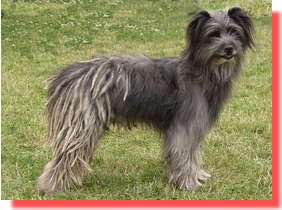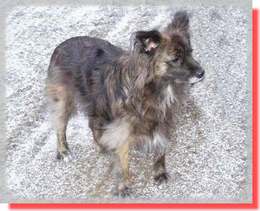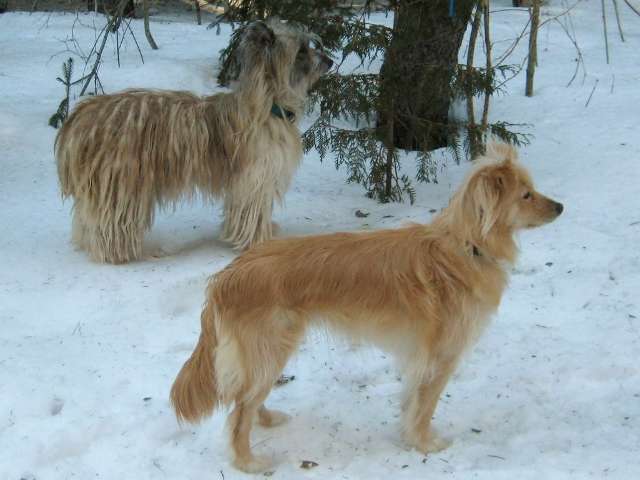

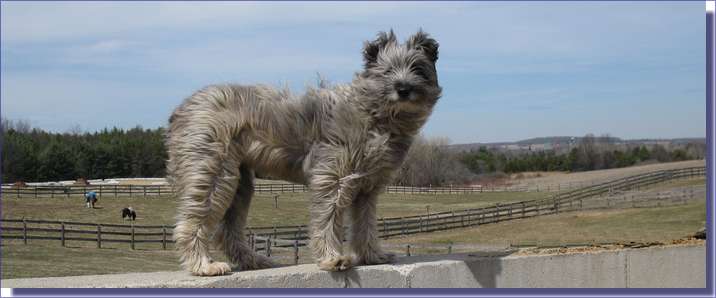


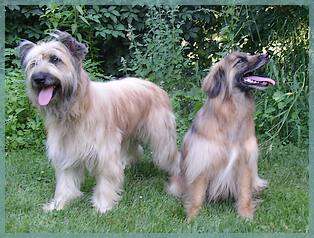 The Pyrenean Shepherd is seen in two coat varieties; the rough-faced
(museau normal) and smooth-faced (face-rase), with minimal physical characteristics
distinguishing the two. Both can be born within the same litter. The rough-faced
variety has a long or semi-long coat covering the body and legs or a long-coat
with slightly longer length. The coat patterning on his face should
look as though he is always facing into the wind. Sometimes this coat
will be of the texture to form "cadenettes" or naturally cord (click to view the process).
The smooth-faced should have no traces of long hair on his face at all.
The body coat is shorter with fringes on the back of the legs. Both
varieties generally have double dew
claws on their back legs (click on the link for more information about
rear double dew claws). This anomaly is seen though out many of
the French breeds. Their tails are usually docked and ears cropped,
but that is a personal preference. A good natural ear should not appear
any different than a cropped ear and a undocked tail should not unbalance
the appearance of the dog by being carried too high. Averaging
42 cm tall (16-17”) at the shoulder, he is light of frame and should only
weigh approximately 12 kilo. (25 pounds)
The Pyrenean Shepherd is seen in two coat varieties; the rough-faced
(museau normal) and smooth-faced (face-rase), with minimal physical characteristics
distinguishing the two. Both can be born within the same litter. The rough-faced
variety has a long or semi-long coat covering the body and legs or a long-coat
with slightly longer length. The coat patterning on his face should
look as though he is always facing into the wind. Sometimes this coat
will be of the texture to form "cadenettes" or naturally cord (click to view the process).
The smooth-faced should have no traces of long hair on his face at all.
The body coat is shorter with fringes on the back of the legs. Both
varieties generally have double dew
claws on their back legs (click on the link for more information about
rear double dew claws). This anomaly is seen though out many of
the French breeds. Their tails are usually docked and ears cropped,
but that is a personal preference. A good natural ear should not appear
any different than a cropped ear and a undocked tail should not unbalance
the appearance of the dog by being carried too high. Averaging
42 cm tall (16-17”) at the shoulder, he is light of frame and should only
weigh approximately 12 kilo. (25 pounds)
Rough-Faced
& Smooth-Faced Fawn Dogs pictured
Although some Pyr Sheps can do well when left alone during the day, I would not recommend it. Only an experienced dog owner willing to spend his limited evening hours socializing his young Pyr Shep should tackle this type of situation and the breed requires a good amount of physical exercise as well. They are a very high energy dog. If you enjoy the outdoors and have a spare hour each day to take a walk in the countryside the Pyrenean Shepherd is an ideal companion.
Their propensity for barking
makes them good watch dogs, they are not guard dogs by nature and, if
pressed, will usually run in the other direction. Nature has instilled
a strong flight reflex which was needed for survival in the mountains.
Their barking must be controlled by you or you will end up with a yappy
dog! On the other hand, if someone or something runs away from them
their herding instinct kicks in and they take chase. All these instincts
need to be harnessed by you in a positive manner to mold the Pyr Shep into
the wonderful family member they are capable of becoming. Obedience
training is very important as is you gaining his respect, and a young dog
should not be allowed to take matters into his own hands but be guided
by your expertise.
Playful and impish by
nature, he gets along well with children as well as with other family pets,
although he often sees the need to take control and be a little bossy. Again,
this stems from his background as a herder. He needs to be kept busy and
feel he has a job and purpose which makes him a valuable asset to his owner.
His world is focused on his family and to be left out is distressing for
him. He excels in performance events such as obedience, agility trialing,
tracking, truffle hunting, cani-cross, ring sport, etc. and is renowned for
holding many working and performance titles in France and other countries.

Some Pyrenean Shepherds have been examined by a canine ophthalmologists and found to have eye anomalies such as persistent pupillary membranes, choroidal hypoplasia (CH) and coloboma and therefore all puppies should have their eyes tested before 8 weeks of age by the breeder before placing the puppy in their new homes. Choroidal Hypoplasia is the inadequate development of the choroid present at birth and non-progressive. Many of these conditions will not affect normal sight of the dog or grow worse with age, but breeders need to be aware of what is being produced by their dogs.


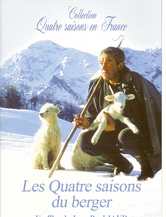
|
Les Quatre Saisons du Berger - DVD French with English subtitles - plays on PAL systems and most computers. (This beautiful DVD should not be missed by anyone interested in the breed.) |

|
Pyrenean Partners: Herding
and Guarding Dogs in the French Pyrenees by Bryan Cummins (English)
Pyrenean Partners is not only a book of exceptional beauty, it is an important contribution to the growing field of ethnocynology — the study of dogs in their particular cultural contexts. The authors take us on a historical and photographic journey into the development and contemporary use of livestock protection dogs and herding dogs — in particular, the Great Pyrenees (Pyrenean Mountain Dog) and Pyrenean Shepherd — as they ply their ancient trades in the French Pyrenees today. Illustrated with magnificent full color photographs of the dogs at work and at rest, Pyrenean Partners examines the distinctly unique relationship each breed has with its owner and their crucial roles in the pastoral economy of the region. Excellent pictures of the Berger des Pyrenees doing his work in his homeland. Available at Amazon.com or Chapters.ca |

|
Le Berger des Pyrénées (French) by Martine Casteran Editions de Vecchi S.A., 20 rue de la Trémoille, 75008 Paris, France ISBN 2-7328-0322-7 |

|
Le Berger des Pyrénées (French) by Joel Herreros Editions de Vecchi, 20 rue de la Trémoille, 75008 Paris, France |
|
|
Le Berger des Pyrénées (French) ATOUT CHIENS Editions |
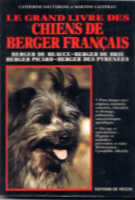
|
Le Grand Livre des Chiens de Berger Français (French) by Dauvergne et Casteran, Edition DE VECCHI |
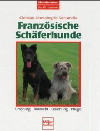
|
Französische Schäferhunde by Christian Janes
and Angelo Steccanella (German) 108 pages about all French Herding Breeds. 30,00 DM, ISBN 3-275-01258-4 |

